-
Posts
15,172 -
Joined
-
Last visited
-
Days Won
465
Posts posted by Nanuq
-
-
You might as well go big, or go home. Right?
Get some Sof Scrub kitchen sink liquid cleanser. It's a thick viscous liquid. Get some Q-tips and practice dipping the Q-tip and then making dots on a piece of paper until you can control your dot size.
Now put a dot of Sof Scrub on one index, covering it from side to side. Count to 8, or 10 if you're feeling brave. Now rinse the dial with a TON of water to get the cleanser off. It's potent and it works fast.
Happy? Do it some more. And post some pics!
-
It's an okay dial but anyone that's familiar with the look will spot it immediately. The font spacing in OYSTER PERPETUAL and SUBMARINER are supposed to be non-proportional. Compare it to this one.

-
Yes it's true gilt relief, made by the Dark Lord using a genuine Rolex pad on a genuine vintage 6538 dial blank that he stripped, using the original factory ink technique.
See if you notice the error in the 2nd picture, that he corrected by the time he made the dial in picture #3. These photos
are of his earlier and later efforts.
-
 1
1
-
-
10 hours ago, one80 said:
I'm happy to send >$5k for a nice franken.
My thinking is that I'll be unlikely to be in a position to buy a 6538/5510 with papers, provenance etc, but I can get something close, even if not 100% gen parts. And even the parts alone will probably not depreciate over time (based on the last 5-10 years).
I know $5,000 sounds like a lot of money. But it's barely scratching the surface to get a reasonably good franken. Mine is based on a MQ case (yes he was a major PITA to work with) and runs an ETA 2846 movement.
In rough terms:
Case $1,000
Crystal $700 - $1,000 (gen T17 Superdome)
Bezel $350
Insert $300 (rep) $2,000 (MKIII gen)
Crown $800
Tube $200
Band $250 (rep Yuki) $2,500 (gen)
Dial $1,000 (MQ)
Hands $300 (rep) $1,000 (gen)
You're already into it for $6,700 plus and that's with a dial any expert can pick out at arm's length and no movement. Throw in a gen ETA 2846 for $300 and then wrestle with having your $1,000 case machined for the correct stem height. Bear in mind, are you SURE you're sticking with the MQ dial and its thickness? Or will you eventually move to a Dark Lord dial and its thickness, if you can find one? They're not the same and your machined case won't accommodate both with a correct stem height. The difference is small, but are you going to cut the feet off a $1,000 dial and use dots? Now start looking for flat gilt hands to match the dial. A member here just finished a project to create nearly perfect hands, and might still have some for sale for the ETA. Otherwise you're into it another $1,000 for good ones. But then the gen spec hands won't fit the cannon pinion on an ETA movement unless you broach/stake the hell out of them, then they rub the minutes hand.
So you get it all put together and tweaked, 3 or 4 or 5 trips to different modders to get it tweaked JUST right. Then you start watching for a Dark Lord dial. Yes they're worth it, they're made on gen plates with gen pads and gen techniques. Mine is. For all intents and purposes they are gen dials. Once you find one, you send it off to the best modder you can find and pray he'll be able to modify the case to accept the dial, then you wrestle with cutting the feet off a gen 6538 dial to mate to the ETA movement. Now we're getting into the realm of ethics. Or you find someone with the skill to drill your ETA main plate to accept the dial feet, which is ridiculously easy to screw up. Now you're servicing your movement again, and you realize... now my dial/movement depth is wrong for how I had the case machined to accept the ETA plus MQ dial with its feet cut off and dial dots. Your new stem height is too high. DAMN. Now what do you do?!
So eventually, after a few expensive mistakes down rabbit holes, you wind up with an aesthetically perfect Big Crown running an ETA movement, put together the right way, and it runs great. It's 7 or 8 years later, and wow does it sparkle on your wrist. But now you realize it looks too "new". This watch is supposed to be 60 years old and it obviously isn't. So now do you start to age your creation? Are you willing to use it HARD and acquire real patina? Do you beat it up to gather artificial damage? Or do you put it on a shelf as a perfect, shiny bauble because nobody will believe a 60 year old watch can look that pristine?
The question is, who do you want to please? You, or other people? Welcome to the world of franken Big Crowns.
-
 1
1
-
-
Just wear it loose so when you bend your wrist you never put strain on it. And keep it clean, so no abrasive dirt builds up in the folds. Mine has looked like this since I got it 22+ years ago, I'm trying to keep it all original.
I did find another 9315 on the 'Bay that I put it on half the time, and Mary's 7836 looks right at home there too, but you'll want a fliplock clasp to make it look legit. That's a good way to get the folded Oyster look, and put the gen bands away for safe keeping. It's also not out of the realm of possibility that you buy Mary's 7836 for sacrificial parts, to restore your 9315 midlinks.
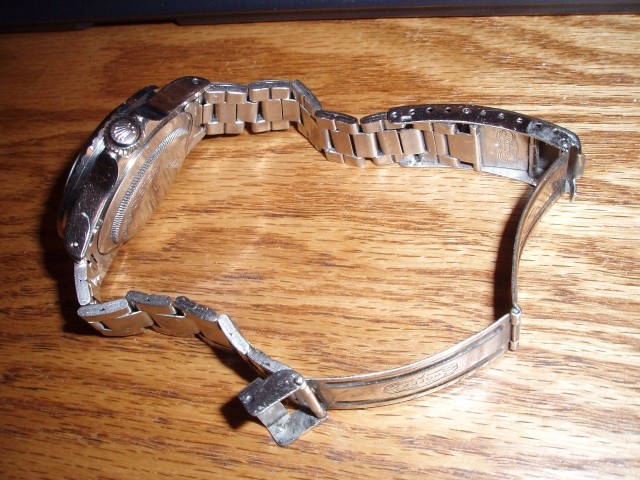
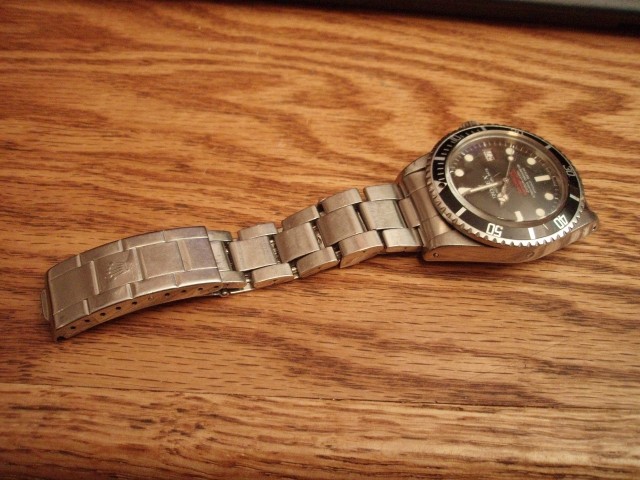
-
-
Looking closely at the stretch, the biggest wear is in the places I circled in green. The midlinks develop a groove across the inside of the "fold" that deepens over time. So if you can get the midlinks replaced you'll be good. The circled red area looks like someone has already replaced a link there.

-
Hi Ronin, I'm afraid there are two paths to follow here. Aftermarket parts "made to work" and genuine.
There used to be two guys in Seattle that could help... Ron Richards in the Joshua Green building, and George Kajanoff in Ballard. Richards was upstairs from Tom Nesbit's shop and between the two of them they could fix anything with "Rolex" on it. Richards' shop is long closed, but Nesbit's is still open. One of his apprentice watchmakers is my go-to guy here in Alaska. George Kajanoff died in 2005 so that whole scene is sort of shut down now to DIY repairmen. Nesbit's shop will probably take your work and can most likely get the parts to do a perfect job. They're beyond amazing, but you pay for what you get.
The alternative is Michael Young. He's been restoring vintage bracelets for decades and he does *spectacular* work. You can reach him here:
http://www.classicwatchrepair.com/english/thecwrworkshop
I have several 7836 bands on my vintage pieces, dressed up to look like 9315s. Problem is, my Popeye wrists mean I need to put in 2 links to make them fit. Mary (on our TD list) has been kind enough to sell me several of her nearly perfect bands, so I picked the best of the bunch as keepers and cannibalized the others for links. It's an easy task to open the midlinks, separate out links (paying attention to the widths as the widths are all different) and inserting them in the appropriate space on the keeper bands. Then I put them shiny side down on a padded leather and strike with a mallet and narrow screwdriver to bend the midlinks back together securely. The results are nearly as good as what Richards used to achieve.
Bear in mind that genuine vintage watches that got used a lot had worn out bands, and replaced links are nearly always "dimpled" just a little on the outer face in the process. So any vintage watch without the dimples either was never used much, or it went through a Rolex Service Center to have the links replaced the right (expensive) way. Here is my 1665 from 1972 with its ridiculously stretched band and two links that Richards replaced. This look is perfectly acceptable in the vintage world.
-
Yeah I looked at the site configuration and sent up a message to the Boss.... all we can do is wait. Sorry!
-
 1
1
-
-
-
I'll send an SOS across the galaxy to our tech expert out beyond Mars.
-
 1
1
-
-
Didn't Freddy333 do a comparison years ago about MB pens? You might have to G**gle to find it though.....
Mont+Blanc+freddy333 site:rwg.cc
something like that.....
-
-
@automatico I am constantly amazed by your depth of knowledge and how willing you are to share it here. We are all better off because of your tireless efforts to spread the good news about Rolex custom projects.

Keep up the good work mate!
-
 1
1
-
-
There was a tutorial here a decade ago about using single edge razor blades to separate the halves. Seems like it would be pretty easy, just don’t cut your fingertips off.
Consider Michael Young too, he can make your band look and feel like new. -
I’ve got watches coming out my ears and my favorite the last 6 months has been a Seiko PADI diver built on the SRP777 platform from Yobokies parts. We’re not watch snobs here, welcome aboard!

-
 1
1
-
-
Hey hey hey!!! Welcome back!!!
-
While you have it apart to this point, try mixing up some tea or cappuccino and paint a little on the hands lume. It tends to migrate to the edges and darkens them a bit, you might like the result.
-
Maria: And so we meet again, Mister Bond.
TJG: You’ll never get me to talk!
Maria: I don’t want you to talk, I want you to BUY. Muwahahahaaaa
Ah the good old days!
-
 2
2
-
-
The Garblefooted voice of Formula One. Godspeed!
-
Welcome aboard! I apologize in advance for the hefty hit your wallet is going to take
 but you won’t find a better place online to learn and share about watches.
but you won’t find a better place online to learn and share about watches. -
What a magnificent result!
-
Wow what a treat to see TJGR back again!!! C’mon now show us some pics of Ollie’s Sea Dweller. Holy smokes was it gorgeous.

-

Strongly recommend Crazy Trusty Cod [censored]-A-Doodle-Doo Mary)



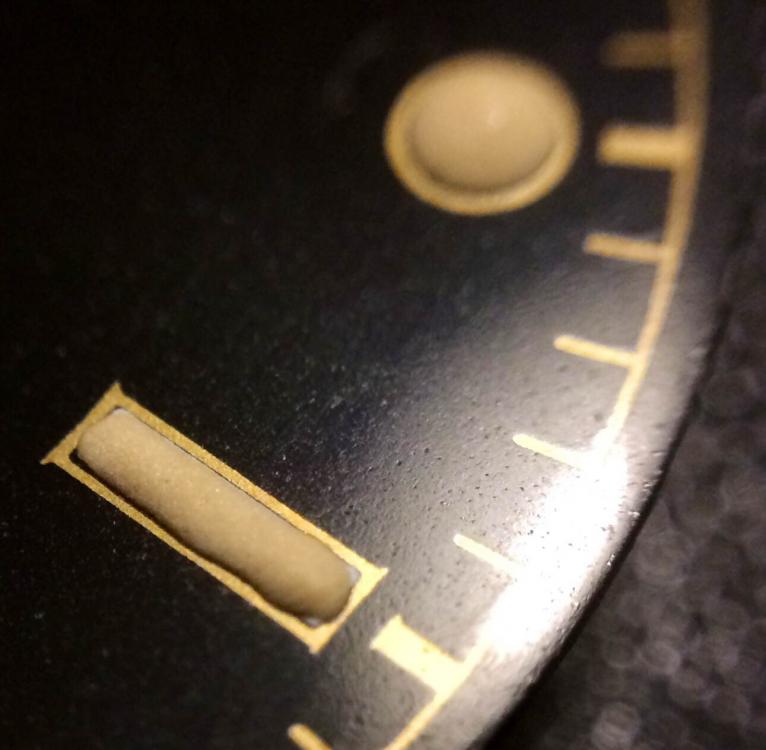
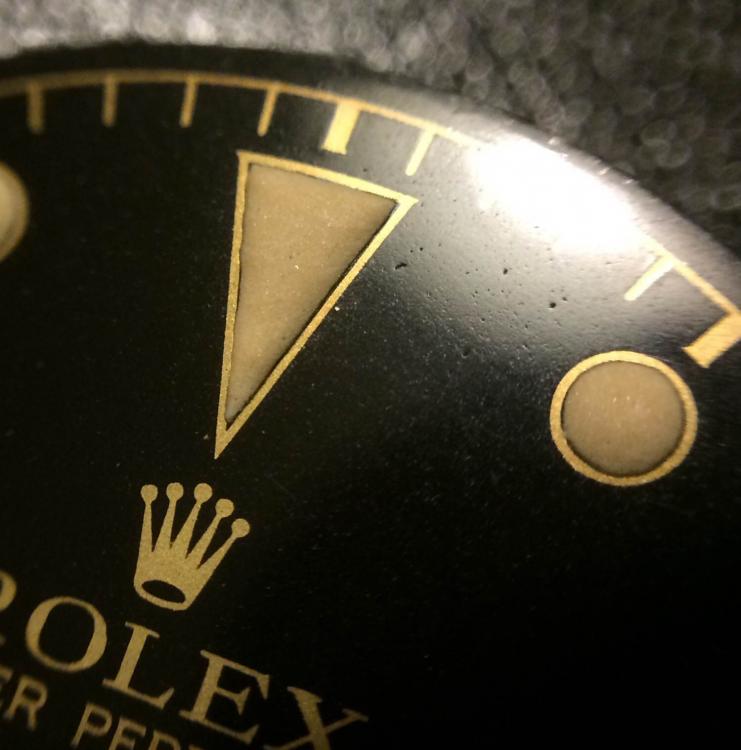
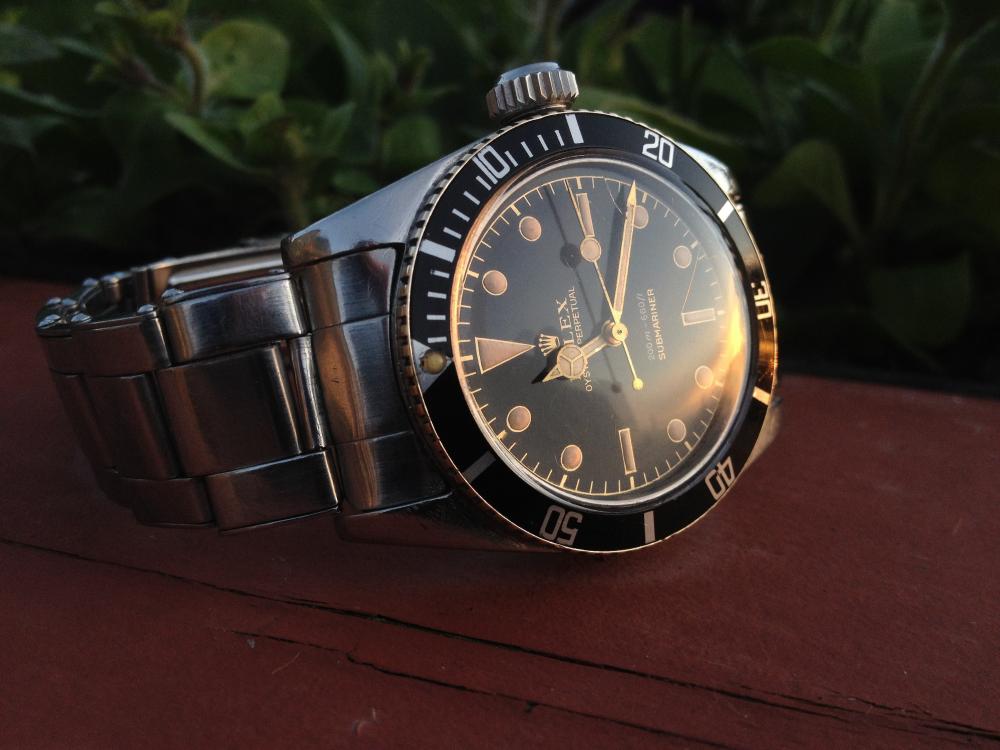
Whitening Indices?
in The Rolex Area
Posted
I haven't done it on a dial but there's no reason it won't work. That's some potent bleach. Put a drop in a stained porcelain sink and within a couple minutes it's pure white. Amazing.
I did use it on my SD43 fiftieth anniversary Sea Dweller, the numerals on the ceramic insert got dingy grey so I filled them with Sof Scrub and let it sit awhile. It sparkled like a Hollywood celebrity's teeth straight from the dentist.